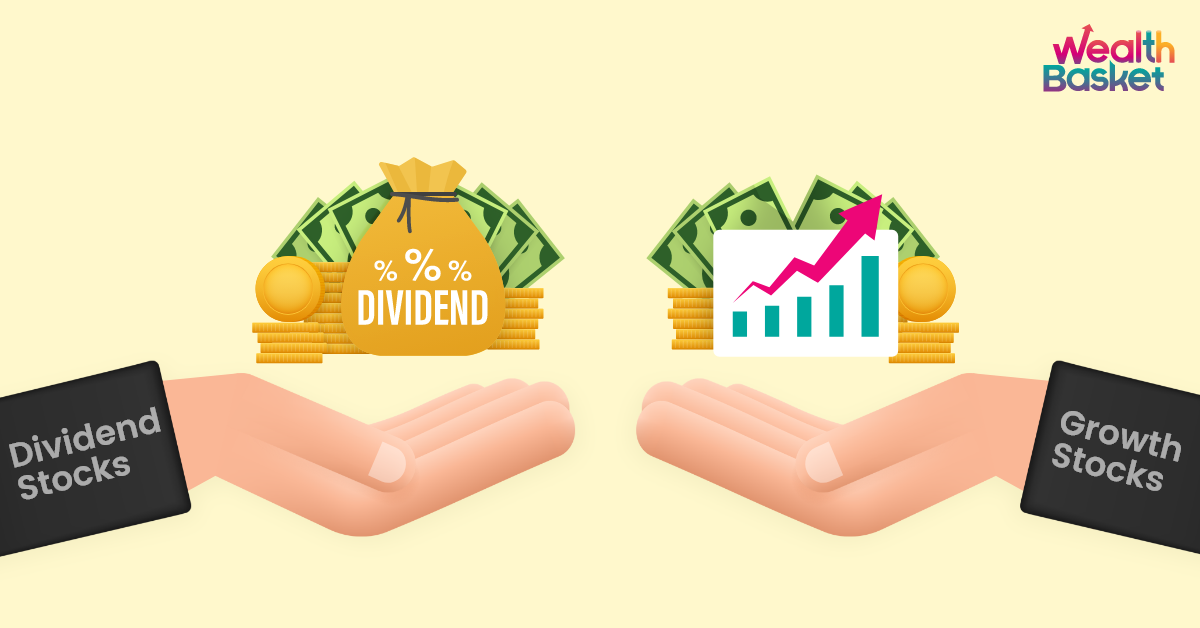When it comes to investing, everyone has a different risk, return, and time horizon preference. Some might be investing for the short term, others for the long. Some believe in high-risk, high-return strategy, while others are happy with less risk and moderate returns.
Stocks are classified on various bases to make stock picking easier for investors. Based on dividend payouts, stocks are classified as dividend and growth stocks.
What Are Dividend Stocks?
Let’s first understand the term ‘dividend’ to understand dividend stocks. A dividend means the part of profit companies share with the shareholders, and those stocks that consistently pay dividends to reward shareholders are categorised as dividend stocks. Investors investing in these stocks would enjoy steady income at periodic intervals.
Characteristics Of Dividend Stocks
-
Higher dividend: Dividend stocks
usually offer higher dividend yields. Dividend yield
means the dividend as a percentage of the stock price.
Suppose a stock price is ₹100 and the dividend is ₹8.
Then, the dividend yield is 8%.
The dividend payout ratio measures the total dividends paid to shareholders compared to its net earnings. If the company marked net income of ₹5,00,000 and paid ₹3,00,000 as dividends to shareholders, its dividend payout ratio is 60%(₹3,00,000 / ₹5,00,000).
- Higher profits: The companies can distribute dividends only when it makes a profit. Companies with dividend stocks usually mark a healthy amount of profits.
- Lower price growth: Dividend stocks may not show significant price growth. Usually, they grow steadily over the years.
- Less risky: Dividend stocks are likely to be relatively less volatile. Plus, the investors at least earn some income in the form of dividends, making them less risky.
Examples Of Dividend Stocks
Many Indian stocks regularly reward their shareholders with dividends. Some examples of high dividend stocks in India are Britannia Industries, Punjab National Bank, Union Bank of India, Vedanta Limited, Indian Oil Corporation, ITC, Ambuja Cements, Castrol India, etc.
What Are Growth Stocks?
Growth stocks are those which are expected to grow at a rate faster than the overall market. Investors holding growth stocks may not earn regular income from stocks, but they may greatly benefit while selling such stocks after a considerable period if their prices have gone up.
Characteristics Of Growth Stocks
- High growth rate: Growth stocks show massive price growth over the years and usually grow at a higher rate than the overall market.
- Higher revenue growth: The growth stock companies’ revenues grow significantly over time, enabling such stocks to offer higher returns to investors.
- Low or no dividends: Growth stocks either pay lower or no dividends since such businesses opt to reinvest their retained earnings instead of distributing them among the shareholders.
- Higher risk: Investors investing in growth stocks earn mainly from price growth and rarely from dividends, and as the price growth is uncertain, there is a higher risk. Plus, these stocks tend to be more volatile than dividend stocks.
Examples Of Growth Stocks
Several Indian stocks have shown tremendous price growth over the years. A few examples of growth stocks in India are KEI Industries, Mindtree, Bajaj Finance, CDSL, Adani Renewables, Infosys, Asian Paints, TCS, etc.
Dividend Vs Growth Stocks: Key Differences
| Point of difference | Dividend stocks | Growth stocks |
| Time horizon | The returns may also be realised in a shorter period. | The returns may be realised in the long run. |
| Cash inflow | The regular inflow of dividends. | Cash inflow at the time of selling of stocks. |
| Risk | Lower risk and more price stability | Higher risk due to high volatility. |
| Price growth | Lower probability for significant price growth. | Higher potential for significant price growth. |
Should You Invest In Dividend Or Growth Stocks?
You may decide whether to invest in dividend or growth stocks after considering your risk, return, and time horizon preference. You may find dividend stocks suitable if you seek stocks with lesser risk, steady returns, and immediate benefits.
In contrast, growth stocks may be suitable if you want greater returns over the years and can stomach the volatility and risk coming along. You may also go for a mixture of both to balance your risk and return.
Final Thoughts
Dividend stocks are well-known for offering higher dividends, and growth stocks are popular for their price growth potential. Dividends and growth stocks have their own pros and cons, and they match the expectations of different investors. Above all, investing only after thoroughly checking the company’s fundamental aspects is essential.
Are you worried about the time required for research for investments? WealthBaskets via WealthDesk can solve this problem. WealthBaskets are the research-backed combination of equities and ETFs based on an idea, theme, or strategy and are built by SEBI-registered professionals.
FAQs
Growth stocks usually do not pay dividends. Instead, such companies may reinvest their earnings into the business, and the shareholders may mainly earn returns from the price growth.
One of the downsides of dividend stocks is that it has a lower potential for offering massive returns. Such companies are likely to distribute more of their earnings to shareholders and not reinvest, which may harm their growth potential.
To be eligible to get the dividend, you must be holding stock in your Demat account on the record date announced by the company.
If you are okay with taking more risks for hefty returns and staying invested for long terms, you may hold less number of dividend stocks. You may keep more dividend stocks if you seek a consistent stream of stock returns.
When the stock price goes down, the dividend yield
goes up. Dividend yield means the dividend as a
percentage of the stock price.
Suppose a
stock price is ₹100 and the dividend is ₹5. The
dividend yield is 5%. If the stock price falls to
₹80, the dividend yield would be 6.25%, provided the
dividend remains ₹5.


















